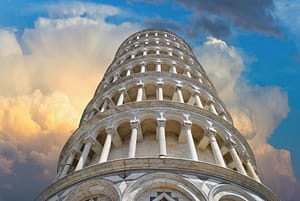Pisa was a major Roman port, but the Arno River has since silted up, leaving it 10 kilometers inland. In 1063, Pisa’s navy was instrumental in defeating the Saracens at Messina and Palermo, beginning Pisa’s rise to control Mediterranean shipping. The cathedral was built in thanks for these victories and enriched by booty brought back by its fleet in the First Crusade. Commerce and industry flourished, and its architects, sculptors, and painters became famous throughout Europe. In 1284, rival Genoa defeated Pisa’s navy, and in 1406, Pisa fell to Florence. But the ruling Médici took a keen interest here, constructing bridges and canals, so the city continued to thrive. Pisa is the birthplace of Galileo Galilei (1564-1642), and legend holds that the cathedral’s swaying chandelier inspired him to design the clock pendulum. Pisa’s main tourist attractions – the Leaning Tower, Cathedral, Baptistery, and Campo Santo – are close together in the Campo dei Miracoli (Field of Miracles), and comprise a UNESCO World Heritage site. If you’re wondering where to eat or go shopping in Pisa, follow Via Maffi from the Campo dei Miracoli to the busy Borgo Stretto, lined with shops, cafés, and restaurants.

